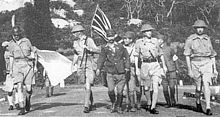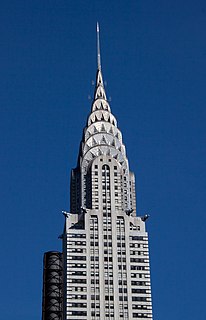
The Sook Ching was a systematic purge of perceived hostile elements among the Chinese in Singapore by the Japanese military during the Japanese occupation of Singapore and Malaya, after the British colony surrendered on 15 February 1942 following the Battle of Singapore. The purge took place from 18 February to 4 March 1942 at various places in the region. The operation was overseen by the Imperial Japanese Army's Kenpeitai secret police and subsequently extended to include the Chinese population in Malaya.

The Battle of Singapore, also known as the Fall of Singapore, was fought in the South-East Asian theatre of World War II when the Empire of Japan invaded the British stronghold of Singapore—nicknamed the "Gibraltar of the East". Singapore was the major British military base in South-East Asia and was the key to British imperial interwar defence planning for South-East Asia and the South-West Pacific. The fighting in Singapore lasted from 8 to 15 February 1942, after the two months during which Japanese forces had advanced down the Malayan Peninsula.

Bukit Batok, often abbreviated as Bt Batok, is a planning area and matured residential town located along the eastern boundary of the West Region of Singapore. Bukit Batok statistically ranks in as the 25th largest, the 12th most populous and the 11th most densely populated planning area in the Republic. It is bordered by six other planning areas - Choa Chu Kang to the North, northeast and northwest, Cashew to the northeast and east, Clementi to the south, Bukit Timah to the southeast, Jurong East to the southwest and Tengah to the west.

Fort Siloso is the sole restored coastal gun battery from the 12 such batteries which made up "Fortress Singapore" at the start of World War II. The fort is situated on Pulau Blakang Mati, an island south of mainland Singapore. The fort is now a military museum open to the public. The Surrender Chambers in Fort Siloso reopened in June 2017 with a refreshed exhibition and free admission.

MacRitchie Reservoir is Singapore's oldest reservoir. The reservoir was completed in 1868 by impounding water from an earth embankment, and was then known as the Impounding Reservoir or Thomson Reservoir.

The Battle of Bukit Timah, was part of the final stage of the Empire of Japan's invasion of Singapore during World War II.

Malaya was gradually occupied by the Japanese between 8 December 1941 and the Allied surrender at Singapore on 16 February 1942. The Japanese remained in occupation until their surrender to the Allies in 1945. The first Japanese garrison in Malaya to lay down their arms was in Penang on 2 September 1945 aboard HMS Nelson.

Bukit Timah Road is a major road in Singapore extending from the city centre to Woodlands Road on the way to Johor Bahru in Malaysia. The road has a length of 25km, which makes it one of the longest roads in Singapore, and the road takes its name from the hill. En route, it passes through the areas of Little India, Newton Road, Farrer Road, Singapore Botanic Gardens and Bukit Timah.
Dalforce, or the Singapore Overseas Chinese Anti-Japanese Volunteer Army was an irregular forces/guerrilla unit within the British Straits Settlements Volunteer Force during World War II. Its members were recruited among the ethnic Chinese people of Singapore. It was created on 25 December 1941 by Lieutenant Colonel John Dalley of the Federated Malay States Police Force. The unit was known to the British colonial administration as Dalforce, after its chief instructor and commanding officer, John Dalley, whereas the Chinese in Singapore only knew it as the Singapore Overseas Chinese Anti-Japanese Volunteer Army. This formation took part in the Battle of Singapore and some members conducted a guerrilla campaign against Japanese forces during the Japanese occupation.

The Bukit Batok Memorial is located on top of the tranquil Bukit Batok Hill upon which once stood two war memorials built by Australian POWs to commemorate the war dead of the Japanese and the Allies who fought during the decisive Battle of Bukit Timah in Singapore during the Second World War. The two memorials were destroyed after the war and only the road and stairs that used to lead to them mark its legacy today.

The Japanese Cemetery Park is a Japanese cemetery and park in Hougang, Singapore. It is the largest Japanese cemetery in Southeast Asia at 29,359 square metres, consisting of 910 tombstones that contain the remains of members of the Japanese community in Singapore, including young Japanese prostitutes, civilians, soldiers and convicted war criminals executed in Changi Prison. It was gazetted as a memorial park by the Singapore government in 1987.

Kent Ridge Park is a 47-hectare public park located in Kent Ridge, Singapore, between the National University of Singapore and the Singapore Science Park. Due to its undisturbed habitat and abundant plant life, it is a popular venue for bird-watchers and eco-tourists.

The Kenpeitai East District Branch was the headquarters of the Kenpeitai, the Japanese military police, during the Japanese occupation of Singapore from 1942 to 1945. It was located at the old YMCA building, at the present site of Singapore's YMCA on Stamford Road. Opened in 1911, the distinctive Art Deco YMCA building was the site of interrogation and torture of many innocent civilians, including the war heroine Elizabeth Choy. After the war, the Singapore government erected several memorials with some at the former massacre sites. In 1995, the former site of the old YMCA building was gazetted by the National Heritage Board as one of the eleven World War II sites of Singapore.

The Battle of Kranji was the second stage of the Empire of Japan's plan for the invasion of Singapore during the Second World War. On 9 February 1942 the Imperial Japanese Army assaulted the north-western front of the British colony of Singapore. Their primary objective was to secure a second beachhead after their successful assault at Sarimbun Beach on 8 February, in order to breach the Jurong-Kranji defence line as part of their southward thrust towards the heart of Singapore City. Defending the shoreline between the Kranji River and the Johor–Singapore Causeway was the Australian 27th Brigade, led by Brigadier Duncan Maxwell, and one irregular company. On 10 February the Japanese forces suffered their heaviest losses while moving up the Kranji River, which caused them to panic and nearly aborted the operation. However, a series of miscommunications and withdrawals by Allied forces in the ensuing battles allowed the Japanese to swiftly gain strategic footholds, which eventually led to the fall of Singapore on 15 February 1942.

Hillview is a neighbourhood nestled within the western region of Singapore. The neighbourhood overlooks the nearby Bukit Timah Hill, hence its name.

Reflections at Bukit Chandu is a World War II interpretive centre developed and managed by the National Archives of Singapore, located on Bukit Chandu off Pasir Panjang Road in Singapore.
The automotive industry in Malaysia consists of 27 vehicle producers and over 640 component manufacturers. The Malaysian automotive industry is the third largest in Southeast Asia, and the 25th largest in the world, with an annual production output of over 500,000 vehicles. The automotive industry contributes 4% or RM 40 billion to Malaysia's GDP, and employs a workforce of over 700,000 throughout a nationwide ecosystem.

Japan–Singapore relations refer to the bilateral relations between Japan and the Republic of Singapore. While the two countries first established bilateral relations in 1966, some of the earliest interactions date back to Japan's invasion of Singapore during World War II. The invasion led to a takeover of the country, after which Japan occupied Singapore for approximately three years before withdrawing following their loss in the war.






























